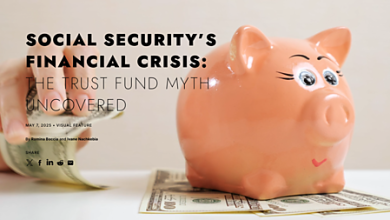American Compass Dystopia: “Rebuilding” American Capitalism

A few weeks ago, American Compass released Rebuilding American Capitalism, A Handbook for Conservative Policymakers. After I provided a very brief critique of the handbook’s “Financialization” chapter in a Forbes column (American Compass Points To Myths Not Facts), Oren Cass, American Compass’s Executive Director, released a response titled Yes, Financialization Is Real. (Cass’s response lists many reports and statistics, but it does not answer my critique of the “Financialization” chapter. I encourage everyone to read Cass’s response, or one of his Twitter threads, to better understand how Cass and his organization produce research.)
To provide a more thorough critique of the “Financialization” chapter, my colleague Jai Kedia and I will release a series of Cato at Liberty posts over the next few days. The present post is the first in the series, and it expands on the most basic of my criticisms: American Compass’s failure to define financialization, the most important term in the chapter.
Although the American Compass handbook does not provide a coherent definition of financialization, it still claims “financialization is a blight on capitalism” and that financialization diverts “resources away from capital intensive projects and toward financial assets.” (See page 59 of the “Financialization” chapter.) In the foreword, Cass warns that “Financialization shifted the economy’s center of gravity from Main Street to Wall Street, fueling an explosion in corporate profits alongside stagnating wages and declining investment.”
None of these scary‐sounding phrases define the term financialization or explain precisely what is (supposedly) diverting resources away from other projects, much less why such diversions are suboptimal. A robust research report would not make such mistakes. It would immediately define the term as clearly as possible to avoid any confusion, a bare minimum requirement to provide well‐supported policy prescriptions to policymakers.
It is true, of course, that effective political campaigns often employ such rhetorical tactics. But American Compass isn’t a political campaign. It claims to be a think tank engaged in serious analysis of economic problems. It is American Compass’s responsibility to clearly define terms and problems so that policymakers (and others) can understand and evaluate American Compass’s recommendations. On this score, American Compass fails miserably.
From the very beginning of the chapter, the financialization concept is so broad that it could be construed as almost anything. For instance, after the chapter introduction acknowledges that “Robust financial markets are vital to a productive economy,” it states:
In recent decades, American finance has metastasized, claiming a disproportionate share of the nation’s top business talent and the economy’s profits, even as actual investment has declined. Businesses, rather than invest their own profits in growth and innovation, increasingly disgorge capital back into the market, where it flows into speculative frenzies that drive the prices of existing assets higher rather than creating new ones. The private equity and hedge fund industries have captured hundreds of billions of dollars in fees while underperforming simple market indices. Strategies that load debt onto companies place workers and their communities at risk while transferring the profits far away. This “financialization” of the American economy weakens the nation and threatens our future prosperity.
Based on this introduction, whatever financialization is, it consists of at least six different concepts. And just in case these concepts aren’t broad enough, the chapter also warns that the “ideas and ideologies” inside of corporations, as opposed to merely financial incentives, “play a primary role in setting business investment decisions.” It then states, “In this sense, ‘financialization’ is also a useful shorthand for the predominance of financial considerations in business management.” (It would be difficult to argue this last version of financialization is some kind of new phenomenon, but I digress.) On Page 62, the “Financialization” chapter includes the following items under the financialization umbrella: “corporate profit strategies and compensation schemes, rival foreign subsidies and industrial policies, [and] cumbersome environmental and permitting regulations.”
Even more confusingly, the chapter also claims the aforementioned resource diversion is both “one definition” and “the most pernicious effect” of financialization.
Further, citing a publication released by Senator Marco Rubio (R‑FL), the “Financialization” chapter argues that “For most of modern American history,” corporations primarily raised capital from the “rest of the economy and spent it on non‐financial assets.” Supposedly, though, “Financialization (whether as cause or effect) disorders this cycle.” The parentheses are included in the original text.
So, while it seems this idea – corporations should invest less in financial assets and more in non‐financial assets – might be the core of American Compass’s argument, it is impossible to tell whether financialization is causing the disorder or whether some disorder is causing financialization. Identifying what is cause and what is effect is a primary responsibility of the authors of such a report.
Yes, American Compass could be arguing that it is both cause and effect, but the question of precisely what financialization is remains a mystery. This critique – that American Compass fails to provide a coherent definition of financialization – is more than a technical matter. This failure is a major research flaw because it is impossible to analyze a problem without identifying the variables that would be affected by it, let alone the cause of the supposed problem.
American Compass uses the term so broadly that it can point to virtually any economic phenomenon or statistic, even a socially beneficial one, as “evidence” of how harmful “financialization” has been. (In this interview, Cass defines the term even more broadly than the “Financialization” chapter.) It allows critics of financial markets to engage in circular arguments, such as: financialization makes corporate profits explode, so public corporations are buying back shares, so investment is declining, which itself is also financialization.
Under such broad terms, anyone could easily associate “financialization” with any number of facts. For instance, financialization may have caused the female labor force participation rate to be almost 30 percentage points higher in 2022 than it was in 1950. Perhaps it caused the percentage of American households with a computer to increase from 8 percent in 1984 to 92 percent in 2018, or real median household income to rise from $50,000 in 1967 to $67,521 in 2020. Maybe it even caused workers with an associate degree to earn $157 more in median weekly earnings in 2020 than those with just a high school diploma.
The problem, of course, is that these kinds of statements amount to little more than opinions because the term “financialization” is used so broadly. And when critics provide evidence against these alleged effects (or causes?) of financialization, American Compass can easily push back by focusing on a different alleged effect or using a different piece of evidence. When critics point out that, for example, investment has not declined, American Compass can easily point to a different investment metric, thus changing the debate.
Obviously, this elusiveness is a great political strategy.
It becomes very easy, for example, to pit “Main Street” against “Wall Street” with what appears to be empirical evidence. It becomes easy to vilify the “speculators” who profit by “trading piles of assets in circles” instead of financing the “real” economic activity that provides jobs to typical Americans. American Compass can simply point out that someone earned high profits or that someone’s income declined. But neither these slogans, nor these simplistic data points, amount to evidence.
This kind of populist attack on finance is hardly new, and it’s one that lawmakers such as Senator Elizabeth Warren (D‑MA) use to vilify “Wall Street” for “looting” businesses. It is eerily reminiscent of the way government officials blamed Wall Street for the Great Depression, ultimately winning support for the Glass‐Stegall Act. It also has some of the populist themes (the common man versus the banks) William Jennings Bryan used in his “Cross of Gold” speech at the 1896 Democratic National Convention, though Bryan failed, three times, to win the U.S. presidency. In fact, many aspects of American Compass’s concept of financialization are virtually indistinguishable from Karl Marx’s concept of fictitious capital versus real capital in Volume 3 of Capital.
With this Cato at Liberty series, we will not try to cover all the different versions and descriptions of financialization that American Compass uses. Instead, we will focus on the specific claims discussed in the original critique along with a few that didn’t make the cut in that Forbes piece. In the next post, we will discuss claims involving the nation’s top business talent leaving for the financial industry.





